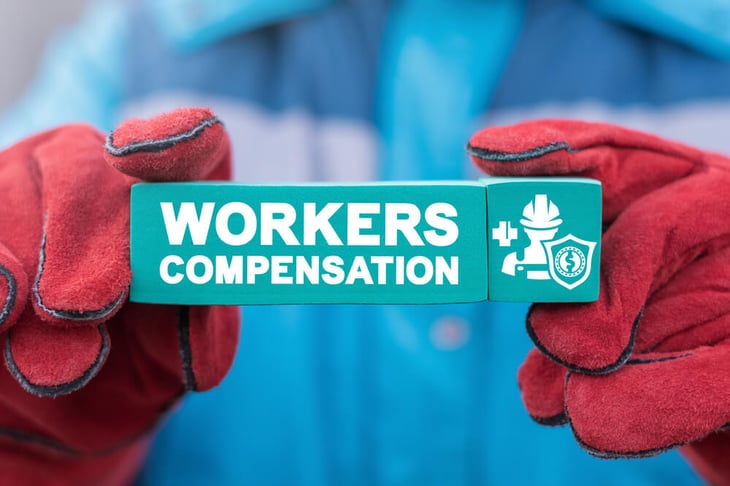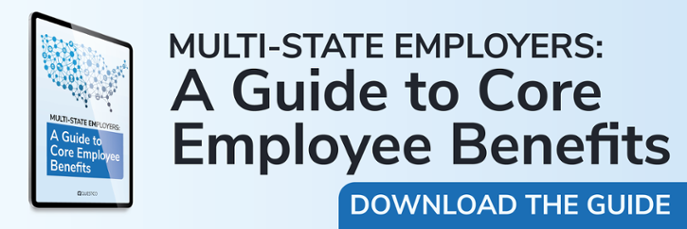Topic HR Strategy,
Solving Common Issues with Multi-State Workers’ Comp Coverage

January 23, 2023 | By Questco

From hefty fines to potential legal action, noncompliance with workers’ compensation insurance laws can be costly and confusing.
The situation worsens for employers dealing with employees across state lines.
Say you hire a remote worker in California. The penalty for not having workers’ compensation insurance is a misdemeanor punishable by a fine of not less than $10,000 or imprisonment in the county jail for up to one year or both.
Challenges range from differential premiums to conflicts between definitions and state requirements. That’s why many multi-state employers are turning to professional employer organizations (PEOs) to navigate this regulatory maze.
Keep reading to learn how joining a PEO’s multi-state workers’ compensation insurance ensures compliance with all state laws regardless of complexity.
7 Common Issues with Multi-State Workers’ Comp Policies
Multi-state employers face unique challenges when obtaining workers’ compensation insurance for employees across state lines.
1. Definitions Change Across State Lines
For starters, the definition of work-related injuries and illnesses varies significantly from state to state. Some states have stricter guidelines for what constitutes a work-related incident, while others have more lenient rules.
Some states only consider injuries on the employer’s property as work-related. Others include incidents that happen off-site but are directly related to the employee’s job duties.
Some states carve out exclusions for specific types of injuries or illnesses, such as stress-related conditions or repetitive motion injuries. Others don’t.
For example, in California, work-related injuries include psychological injuries, such as stress or depression, that are caused by the work environment.
In contrast, in Texas, the definition of a work-related injury or illness is limited to physical injuries caused by an accident or specific event. This means that Texas’ workers’ compensation insurance laws won’t cover psychological injuries, while California’s will.
2. Differences Between State Requirements
Besides differences in definitions and exclusions, each state has its own requirements for when and whether workers’ compensation insurance is necessary.
In New York, employers are required to carry workers’ compensation insurance if they have even a single employee. In contrast, employers in Texas do not have to carry workers’ compensation insurance unless they have a certain number of employees or if they operate in specific industries.
Compare these to California and Nevada, where all employers must carry workers’ compensation insurance coverage for their employees, regardless of the number of employees.
Do you know which is which offhand?
3. Employees Temporarily working Out-of-State
What happens when an employee is injured while temporarily visiting?
Will your workers’ comp coverage extend to that state?
It all depends on that state’s regulations on extraterritorial coverage and reciprocity agreements.
Extraterritorial coverage is when a state’s workers’ compensation laws apply to injuries or illnesses outside the state. If the employee is temporarily working in another state, they are still covered under their home state’s workers’ compensation laws.
Reciprocity agreements occur when states recognize each other’s workers’ compensation laws. Suppose an employee is injured while temporarily working in a state with a reciprocity agreement. In that case, they are covered under the workers’ compensation laws of the state where their employer is based.
For example, New Jersey and Pennsylvania have a reciprocity agreement. This means that if an employee from New Jersey is temporarily working in Pennsylvania and becomes injured or ill, they would be protected under New York’s workers’ compensation laws.
However, not all states have extraterritorial coverage or reciprocity agreements.
4. Finding Multi-State Workers’ Comp Carriers
Insurance agents may not have the necessary permissions or approvals to sell policies in certain states. Most carriers are not licensed to operate in all 50 states.
Even if an insurance provider can operate in multiple states, they may not have the resources or expertise to provide coverage that complies with different states’ workers’ compensation laws.

5. Getting Coverage in Monopolistic States
Another obstacle you may face is finding workers’ compensation coverage in states with monopolistic systems.
But what exactly are monopolistic states?
These are states where the government is the sole provider of workers’ comp coverage, rather than private insurance companies. If you have employees working in these states, you must purchase workers’ compensation coverage directly from the state insurance fund rather than shopping for a private carrier.
State funds may not offer the same coverage or flexibility as private carriers. They often have stricter rules and regulations that must be followed, making it harder for employers to get the coverage they need for their workers. And let’s not forget the potential for higher rates, as state funds may not have the same competitive pressures as private carriers.
As of 2023, the monopolistic states are North Dakota, Ohio, Washington, and Wyoming.
6. Impact on Interstate EMRs
Experience modifier rates (EMRs) are numerical values insurance carriers use to adjust the premium for a policy based on an employer’s past claims experience. These rates are determined by the carrier and are specific to each state.
The National Council on Compensation Insurance (NCCI) uses interstate ratings for premium adjustments based on the employer’s claims experience in other states. This system recognizes that employers with a history of claims in one state may pose a higher risk of claims in other states.
For multi-state employers, this can be a double-edged sword.
On the one hand, if you have a good claims history in one state, you may be able to secure a lower EMR in another state. However, if you have a poor claims history in one state, you may receive a higher EMR in the state where you have a good claims history.
Interstate ratings also make it difficult for multi-state employers to predict workers’ compensation insurance costs, as they may be subject to different EMRs in each state.
7. Classifying Independent Contractors
Another challenge involves the designation of independent contractors. Each state has its own criteria for determining whether a worker is an employee or not.
For example, California uses the “ABC test” which considers a worker to be an independent contractor only if:
- The hiring entity establishes that the worker is free from the control and direction of the hiring entity
- The work is performed outside the usual course of the hiring entity’s business.
- The worker is customarily engaged in an independently established trade, occupation, or business of the same nature as the work performed.
Other states use the “right to control” test, which focuses on the level of control exercised by the employer over the worker.
Misclassifying employees as independent contractors can lead to significant fines. If the IRS determines that an individual has been misclassified, it may levy penalties such as:
- A $50 fine for each Form W-2 the employer failed to file because of classifying workers as independent contractors.
- A penalty of up to 3% of the wages and up to 40% of the FICA taxes that were not withheld from the employee.
- Up to 100% of the employee’s share of the taxes that should have been withheld.
Even if the misclassification is unintentional, you could still face fines.
Why Multi-State Employers Turn to PEOs
If these problems sound like an overwhelming bureaucratic headache, you may be the perfect candidate for a partnership with a professional employer organization (PEO).
What is a PEO?
A professional employer organization provides comprehensive human resources outsourcing services such as multi-state payroll processing, employment tax remittance, and HR compliance guidance.
Then, there is the matter of employee benefits.
When you join a PEO, you gain access to Fortune 500-level group health insurance at a more affordable cost than you could get on your own.
This is possible because PEOs function as a co-employer. A co-employment agreement means that the client company retains control over day-to-day employee management while the PEO acts as the “employer of record” for legal purposes. This makes it possible for PEOs to remit your payroll taxes under their Federal Employer Identification Number (FEIN).
As an employer of record for multiple businesses, PEOs can pool worksite employees from all clients to achieve economies of scale. That means negotiating better rates and more comprehensive coverage options with insurance providers.
How PEOs Obtain Workers’ Compensation Across State Lines
PEOs can offer their clients cost-savings on multi-state workers’ compensation coverage by combining economies of scale and a network of national insurance carriers.
Even in monopolistic states, where only state-funded insurance plans are available, PEOs can secure coverage by demonstrating their substantial size and experience as group insurers.
Workers comp cost-savings primarily depend on what types of policies a state allows. Generally, there are two types of PEO policy issuances, but access to either depends on the state and whether the coverage is written through voluntary or residual markets.
The Master Policy
This standard workers’ compensation policy is written in the name of the PEO and covers the worksite employees of multiple client companies and the direct workers of the PEO. Master policies achieve the greatest economies of scale. Under a master policy, the PEO is the only named insured, and all the client’s worksite employees are covered under one policy, regardless of the state in which they are located.
When a PEO has a master policy, a single experience rating modifier applies to the PEO and worksite employees. If your EMR is high, joining a PEO with a master policy can bring that rating back down.
That means reduced workers comp premiums.
The Multiple Coordinated Policy
Under an MCP, the PEO has its own workers comp policy covering only its direct employees. Each client company has its own standard policy covering its employees. Each client files under their own Federal Employer Identification Number (FEIN).
Coverage is coordinated between the client company and PEO through the use of endorsements. The policy must contain the name of the PEO as the primary name insured regarding the client company.
In this arrangement, the client’s worksite employees’ payroll and loss data is reported to NCCI for each policy per NCCI’s Statistical Plan. The NCCI calculates an experience rating modification for each eligible client and PEO. This can result in a different EMR for the client company and the PEO.

Other Ways PEOs Help You Save on Workers’ Compensation Insurance
If you live in a state with a Master Policy, your most significant savings may come from lowering your EMR.
But what if your state only allows for multiple coordinated policies? Does partnering with a PEO lend any other advantages than EMR reduction?
Absolutely.
Joining a PEO’s policy can result in cost savings beyond reduced EMR. For instance:
- Return-to-Work program: Your PEO will set up a Return-to-Work program for you, which helps get injured employees back on the job as soon as possible. This can help speed up recovery time and save your company money by reducing lost time.
- Claims administration: Your PEO will handle the claims administration process for you, saving you significant time and hassle. They will work with the insurance carrier to ensure claims are handled efficiently and effectively and provide support for your employees throughout the process.
- Yearly premium audit: Your PEO will do your annual premium audit for you, saving both time and money. They will work with the insurance carrier to ensure all information is accurate and up-to-date and will also support your employees throughout the process.
- NCCI classification codes: Your PEO will review NCCI class codes and optimize them for you, which can save you money on your workers’ compensation insurance premium.
- Risk control services: A PEO will provide risk control services for you, which can help you identify and mitigate potential hazards in your workplace. This can help reduce the likelihood of workplace accidents and injuries, which can ultimately save you money on your workers’ compensation insurance premium.
From navigating different state requirements to dealing with extraterritorial coverage, it’s no wonder that many multi-state employers are turning to PEOs for help. PEOs have the expertise and resources to ensure compliance with all state laws, regardless of complexity.
Don’t let the confusion and headache of multi-state workers’ comp policies bring your business down - join a PEO’s policy today and sleep easier knowing that your employees and your bottom line are protected.
Please note that the information presented above is not intended to be specific, technical, or professional advice. Our aim is to educate and provide insight into relevant topics.



